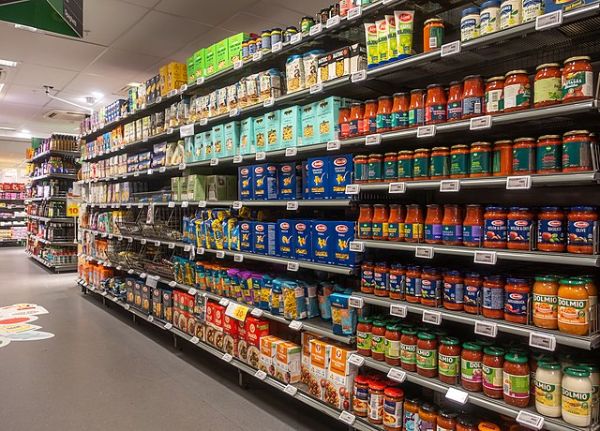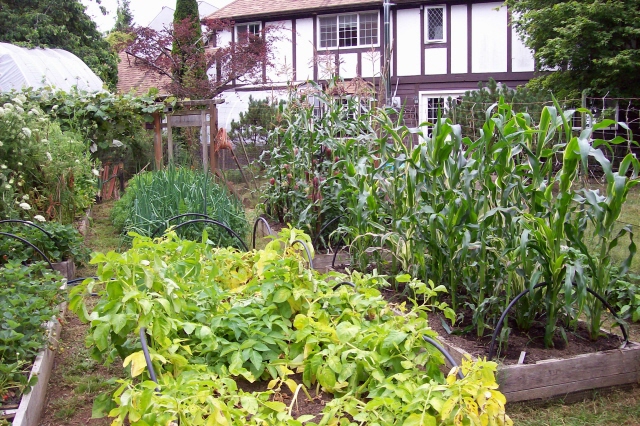FROM 2013: As with every such transition, the move from an industrial food diet to a homegrown, organic one is likely to occur in gradual stages.
As people improve their gardening skills and devote more of their time and attention to sourcing healthy, natural foods from local growers and producers, they can slowly but surely eliminate the processed foods from their diets.
Flashback Show Notes
Episode 460 – The Future of Food
TRANSCRIPT:
The modern supermarket is less and less a place to purchase food for the household and more and more a warzone where shoppers have to negotiate a minefield of toxic chemicals and additives. From processed foods with their string of unpronounceable ingredients to the “fresh fruits and vegetables” saturated in pesticides to meat and dairy products from industrial farms where animals are raised on a diet of growth hormones and animal waste to the ever-present and ever-growing danger of GMO contamination of nearly everything, feeding healthy, nourishing food to your family is quickly becoming difficult, if not impossible, through the industrial food system.
Perhaps the worst part of this phenomenon is that, as specialist stores begin to cater to the demands of their economically comfortable clientele for fresh and organic foods and ingredients, it is the poorest members of society who are increasingly targeted by these health hazards.
AARON DYKES: There’s always lots of nice products standing out at the grocery store. This one caught my eye because it’s classy and it’s on sale and it’s filled with more GMO ingredients per item than just about anything I’ve seen.
Let’s take a look at Klass Horchata, which is a powdered drink mix. It’s got dextrose, sugar, titanium dioxide, maltodextrin, partially hydrogenated vegetable oil (which may contain soybean, canola and/or palm oil). It’s got skimmed milk powder, artificial flavour, guar gum, silicone dioxide, aspartame, powdered cinnamon, rice flour, acelsulfame potassium and ascorbic acid and caramel color. And that’s far too many GMO ingredients, but it’s on sale and pitched . . . I’m going to go ahead and say, to a “certain” class.
SOURCE: Lower Income Grocery Store Features Items with Even More GMOs
For a generation that has been raised on processed foods and microwave dinners, it may be hard to imagine that any alternative to these products are available. For those who are interested in sourcing healthy alternatives to the chemical concoctions that pass for food these days, there are, as always, a host of excuses for why they can’t buck the status quo and say no to the food conglomerates that control so much of our modern food supply: It’s too expensive to buy fresh, organic foods. It’s too time-consuming to prepare foods from scratch. There isn’t enough time or space to grow your own fruits and vegetables.
Ironically, as more and more people fall through the cracks economically—with a record 47 million Americans now relying on food stamps to help keep food on the family table—the apathy and inertia around these issues is beginning to fade. In the last several years we have seen a resurgence in the concept of “victory gardens” and urban gardening generally as millions of people around the globe begin to rediscover the practicality—not to mention the simple joys—of growing their own food.
In fact, as some of these families have shown, the space limitations of urban environments need not be an impediment to the truly dedicated urban gardener.
REPORTER: Drivers whizzing past on the 210 freeway through Pasadena have no idea that a stone’s throw away from the fast lane is a lush but tiny Eden, a 4,000-square-foot farm. It not only feeds a family, but revolutionizes the idea of what can be done in a very unlikely place, the middle of a city.
JULES DERVES: This is city living. But I brought the country to the city rather than have to go out to the country. I just imported it.
REPORTER: 63-year-old Jules Derves started this backyard farm 10 years ago. It’s a deliberate throwback to the storied days of self-reliant rural America. Sustainable and dense, on their 4,000 square feet, they raise 400 varieties of vegetables, fruits, and edible flowers. 6,000 pounds a year, enough to feed themselves with plenty left over.
SOURCE: Urban Agroecoloy: 6,000 lbs of food on 1/10th acre – Urban Homestead – Urban Permaculture
As study after study and report after report continues to confirm the dangers of modern chemical additives, pesticides and ingredients, backyard gardening and participation in local farmers markets is quickly transforming from a fringe movement to a major cultural phenomenon. Recently, I had the chance to talk to Aaron Dykes and Melissa Melton of TruthStreamMedia.com about this phenomenon and just how easy it is for people to begin transitioning off of the industrial food chain.
JAMES CORBETT: So I think the question is, what can actually conceivably be done about this? And again, I think this has to come back to that idea of, at the very least, we still control what we eat and what we don’t eat. And we still vote with our dollars every single day as to what products we’re going to put in our mouth and what we’re not. So is there a way that people can actually source this for themselves without waiting for some sort of federal labeling law?
AARON DYKES: James, I don’t want to be nostalgic here, but in so many ways with world order, I’d love to go back to before World War II, or in this case, at least during World War II, we’ve got to talk about Victory Gardens as a solution. And I think people en masse need to start growing whatever they can for vegetable gardens, raising their own food. And we’ve got to revitalize local in every sense, not the global local that they’ve been pushing through Agenda 21. And the rhetoric is going to remain tricky because these people have been shaping these systems for hundreds of years. And you heard Kissinger in the 70s. He wants nothing short of food as a weapon.
MELISSA DYKES: Straight up.
AARON DYKES: They want to control the entire food supply so that populations remain compliant to this global world order. We can basically defeat that as best as we’re going to be able to by decentralizing that, taking back any part of your production. If you’re not going to do a garden, figure out who your neighbors are down the road, start a relationship. But, you know, there’s a million ways you could do it. We started just growing sprouts in our kitchen because we’re not ready for a full-on vegetable garden.
MELISSA DYKES: Yeah. You can do that in like two or three days with just water and sprouts on your countertop. And then you have food. We’re also going to start making a lot of videos. And we’ve been doing this a little bit just to show how with all this “convenience” food, everybody thinks that they’re saving so much time. But actually, if you go back to just making it yourself, you not only save time, but money. And you don’t have a bunch of ingredients in your food that you can’t even pronounce.
SOURCE: Interview 704 – Aaron Dykes and Melissa Melton on GMO Labeling
For those who are not confined to the space limitations of the urban environment, the ability to maintain a year-round harvest of fresh foods is even easier. As no shortage of online guides and tutorials will attest, raised bed gardening not only allows those in more rural locations the ability to feed healthy, homegrown food to their family on a regular basis, but also to reconnect with the natural environment and provide the calm and respite that is so often lacking from modern life.
Recently I had the chance to discuss gardening with Leon Pittard of Fairdinkum Radio in Australia, including how soil development can be an essential part of the home gardening process.
CORBETT: So let’s talk a little bit about your setup in particular. Tell us about the raised beds that you have, how many plants that you have, and what it is you’re planting.
LEON PITTARD: We’ve got five different raised beds at the moment, and that’s actually developing. But in those raised beds, I’ve developed the soil. And a very important part to understand about growing your own food is that, yeah, [GARBLED] like a beet, look at the inputs. And when we look at even the research community, we’re often talking about the media, which is an input into the life. And food is really just another input into our lives that sustains us and and actually helps to grow our health and sustain our health and so plants also need inputs. And so, it’s particularly important to understand that we start from a good place.
And I focus a lot on actually developing the soil from a variety of different methods composting and adding lots of high nutrition to that soil so that when you do actually grow your seedlings and grow your plants, it’s important that your plants are full of that power and minerals and life that’s in the soil. And so, just as the blood is the life for our body, so the soil is the life for the plant. And so I focus a lot on minerals and actually building the soil as a base and having that soil but it’s really high powered so that the food we eat, you can really notice a difference.
In those five beds this year, we’ve basically sustained ourselves 100% with greens, as in lettuce and spinach and high-powered greens like broccoli. We’re growing out cauliflower. We’ve got garlic in all the time, snow peas, beetroot. And what I try and focus on is that we actually graze off the garden. Most commercial planting enterprises basically grow a vegetable until it’s huge, and then they pluck it out. So you’ve got a crop all coming on at once but what we do is actually eat little bits of it all the time. In other words, you can be taking—we eat the beetroot leaves, the the broccoli leaves. I put in juices. I juice organic carrots, apples and broccoli leaves and stems, and that provides a real high-powered chlorophyll mix with with the vegetables.
And the thing is, with having your mineral base really powerful in your soil, your plants actually grow a natural ability to resist pests. And of course we don’t use any pesticide or anything like that. And if the plant is healthy, basically it’s going to resist pests, or the pests aren’t going to be a problem. I mean, I don’t mind if some caterpillars or something eat a few leaves. I mean, it doesn’t matter if you grow enough food to share, right? And the idea is not to look at those things as “bad,” because they’re actually all a part of the ecosystem.
And so, basically, what we do in those beds is focus on really good soil quality, which delivers really good plant quality. And obviously when you eat that then that those minerals actually are the minerals that our bodies need. And so what we do as a maintenance program, I actually put seawater on my plants at 100-to-1 ratio. I dilute the seawater 100-to-1 and I run my plants and my trees every week with that mix and you can see a difference in the leaves. Like, sometimes, if if trees or plants are lacking minerals, you’ll see they’re spotted, or they’ll have discoloration. And if you maintain this sea water application, the plants will actually absorb all those minerals and you can see that the leaves change to a glossy, healthy color. And in some of the videos, you’ll see our leaves they’re shining. You can go into into the corporate food industry, you can’t see lettuce that’s shining or beetroot leaves are actually glowing at you.
And, you know, we can go down there and basically pick the leaves or snow peas and just eat them straight off. Some beautiful, sustaining food. And my wife makes beautiful broccoli quiches and cauliflower soup and, oh, James, you know, growing your own food! It’s just so satisfying, you know? And i can feel it in my own health too and, yeah, it’s a great, wonderful, satisfying thing to do.
SOURCE: Interview 713 – Leon Pittard on How to Grow Your Own Food
As with every such transition, the move from an industrial food diet to a homegrown, organic one is likely to occur in gradual stages. As people improve their gardening skills and devote more of their time and attention to sourcing healthy, natural foods from local growers and producers, they can slowly but surely eliminate the processed foods from their diets.
And this, as with all such boycotts, is the real promise of the homegrown food revolution. There is nothing that we as individuals can do to directly influence the policies of the Federal Reserve or the practices of the NSA or the foreign policy of the US/NATO empire. But we can directly choose what foods and products we support with our dollars and what food we put on our families’ tables. Not only can we make that choice, but we do actively make that choice each and every day, whether by default or by conscious action. If we, in the full knowledge of the devestating health and environmental effects of the big food conglomerates, continue to support those corporations with our money, then we are complicit in their activities. To the extent that we withdraw our support and begin to seek out and build up alternative infrastructures for producing healthy foods, we are part of the solution.
The choice is ours to make, and this revolution, like the Wall Street boycott, the Big Tech boycott, and all the other boycotts of the corporatocracy that are possible, begins the next time you walk into a store and purchase—or refuse to purchase—one of their products.
Author
An award-winning investigative journalist, James Corbett has lectured on geopolitics at the University of Groningen's Studium Generale, and delivered presentations on open source journalism at The French Institute for Research in Computer Science and Automation's fOSSa conference, at TedXGroningen and at Ritsumeikan University in Kyoto.
He started The Corbett Report website in 2007 as an outlet for independent critical analysis of politics, society, history, and economics. Since then he has written, recorded and edited thousands of hours of audio and video media for the website, including a podcast and several regular online video series. To support The Corbett Report and to access the full newsletter, please sign up to become a member of the website.
TLA recommends Corbett's site for excellent analysis of most global issues excepting climate and China where his substantiation appears quite thin. ~ Ed.





